I love the bright yellow flowers of black-eyed Susans (Rudbeckia hirta). They’re just so bright and cheery. Not to mention so many different types of pollinators will visit their flowers and then the birds love to eat the seeds later in the year.
Black-eyed Susans are also easy to grow in a variety of soil types. Also, unlike many native plants, black-eyed Susans will often bloom the first year they are planted. That means they can provide almost instant gratification. For those reasons, and many more, I often find myself recommending black-eyed Susans for those wanting to grow native plants.
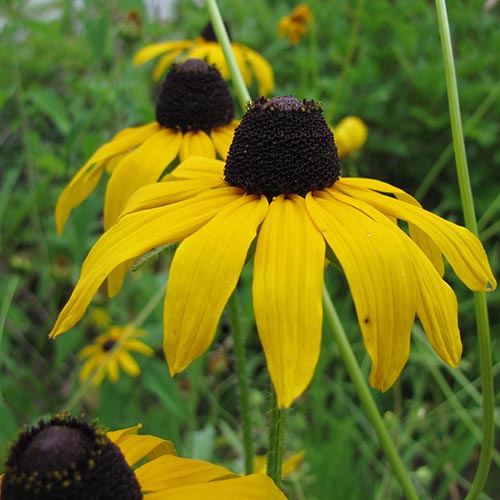
Native Range
The native range of black-eyed Susan (Rudbeckia hirta) covers most of the eastern half of the U.S. with some native populations scattered slightly further west. There are also several places west of the Rockies where it is introduced because it originally planted in gardens but then escaped cultivation and can now be found growing in the wild.
Common Names Can Be Confusing
Now before I go any further, I think it is important to point out that there are multiple species within the genus Rudbeckia. In the eastern U.S. alone there are around half a dozen different Rudbeckia species. Some of those species are also sometimes called black-eyed Susan because they look somewhat like black-eyed Susan (Rudbeckia hirta).
That means, as always, common names can be confusing. So, pay attention to the scientific name of any plant that you are buying or considering planting. Just because two plants look similar doesn’t mean that they have the same growth characteristics or will even do well in the same locations.
How to Identify Black-eyed Susan
Black-eyed Susan has simple, unlobed leaves that are arranged in an alternate pattern along the stem. The leaves and stems are rough with stiff, bristly “hairs.” In fact, the “hirta” part of Rudbeckia hirta is derived from the Latin word for hairy. The flower has bright yellow petal-like structures that surround a dark brown, flattened cone-like center.
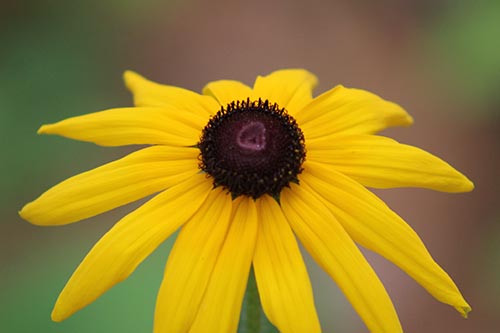
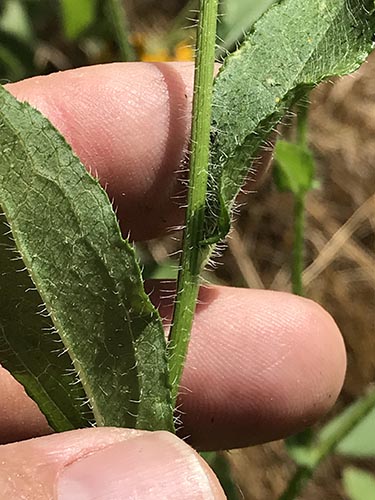
Biology and Life History
The black-eyed Susan belongs to the Asteraceae family – the same family as purple coneflowers, sunflowers, asters, and many others. Like with all species in this family, what we think of as an individual flower is actually a composite of many smaller flowers.
With black-eyed Susans, the bright yellow “petals” are actually sterile ray flowers whose sole purpose is to attract pollinators. Think of them as the big flashy billboard or sign. The brown center is made up of lots of individual flowers containing nectar and pollen. (They’re called disc flowers.) The disc flowers closest to the yellow ray flowers bloom first and the ones in the very center bloom last.
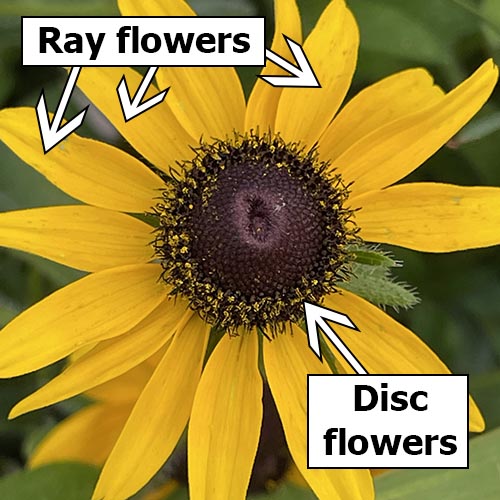
I sometimes see the black-eyed Susan listed as an annual or a biennial. It’s not. Annual plants complete their entire lifecycle in one year and then die. Biennials produce vegetative and root growth the first year, bloom the second year, and then die.
The black-eyed Susan is what’s called a short-lived perennial. This means that each individual plant only lives for a few years. In the case of black-eyed Susans, that’s usually 1-3 years and it may bloom each of those years. It’s not stuck with just blooming once before it dies like annual and biennial plants do.
Pollinator and Wildlife Uses
Black-eyed Susans are used by a wide variety of pollinators and wildlife. Butterflies of all kinds, especially some of the smaller species, can be found drinking nectar from the flowers. A wide variety of native bees will also visit the flowers for nectar and pollen, with a few of those native bee species being pollen specialists on either Rudbeckias or closely related genera. Several of the flower flies also commonly visit black-eyed Susan flowers. I’ve even seen hummingbirds visiting the black-eyed Susans in my garden both to catch bugs and to nectar.
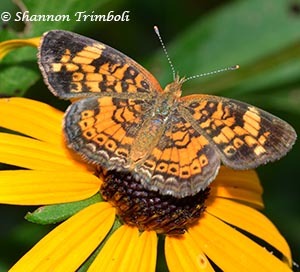
Because the leaves are rough and hairy, deer tend to mostly leave it alone. (Notice that I said “tend to” and “mostly.” If your deer population is high enough and the deer are hungry enough, then yes, they will sometimes munch on it. It’s deer resistant, not proof.) However, the leaves are often eaten by silvery checkerspot caterpillars.
After the flowers go to seed, goldfinches and other seed-eating birds will often devour the seeds.
Incorporating Black-eyed Susans into Your Yard
I love including black-eyed Susans in garden settings because of how bright, cheerful, and pretty the flowers are and because of how much the pollinators and wildlife use them. Black-eyed Susans like sunny to mostly sunny locations, tend to be somewhat drought tolerant, and can grow in a wide variety of soil types and conditions.
Something else I love about the black-eyed Susan is that it has a long bloom time, often lasting a month or more. I think they look amazing when planted in large clumps or drifts. It also produces abundant seeds. Those seeds are really important if you want to maintain black-eyed Susans in your garden.
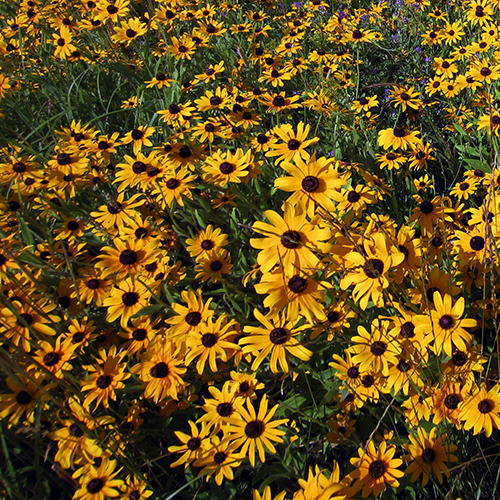
Remember, I said this was a short-lived perennial and each individual plant typically only lived 1-3 years? That means that in order to persist in the garden, you’ll have to let some of those seeds germinate. (In other words, don’t deadhead them all.) Also, if you want to keep black-eyed Susans in that area, don’t let other plants overtake and shade out the new seedlings as they are getting started. Although that brings up another way to possibly use black-eyed Susans in your native plant or pollinator garden.
Many of the species that are often included in pollinator or native plant gardens are medium to long-lived perennials. It may take these species 2-5 years to really get going and start blooming. Even some of the other Rudbeckia species which are sometimes called black-eyed Susans fall into this category. Like I said before, just because two plants share the same common name doesn’t mean they share the same growth characteristics or life history. And let’s face it, if most of your plants don’t start blooming until they are 2-5 years old, then that can lead to a really boring garden the first year or so while you’re waiting for things to get big enough to flower.
One solution is to plant lots of black-eyed Susans to give you instant gratification for the first year and for the next few years. Then as the older-lived and slower to get going species begin get bigger and start blooming, let them naturally shade out the new black-eyed Susan seedlings and take the place of the original black-eyed Susans as they die out. This is a tactic that is often done in large pollinator plantings and is why a field that was all black-eyed Susans the first year it was planted may have very few black-eyed Susans left by year 5. You can use the same principle on a smaller scale in your garden.
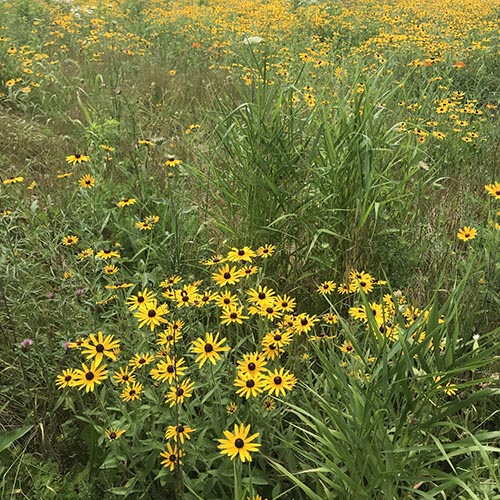
Cultivars and More Common Name Confusion
The beautiful, cheery flowers and easy to grow nature of black-eyed Susans has made it a staple in the traditional horticulture field for ages. It’s relatively easy to find, even in big box stores. But, be careful because many of those individuals will be cultivars or not even the true black-eyed Susan, Rudbeckia hirta.
For example, Goldsturm black-eyed Susan is perhaps the most well known variety or cultivar bearing the black-eyed Susan name. But it’s a cultivar of Rudbeckia fugida, a.k.a. orange coneflower, not R. hirta! Also, as with most cultivars, pollinators and wildlife may not use it as much as they do the straight species.
Summary
Black-eyed Susan is a beautiful native plant that can be found throughout most of the eastern U.S. and makes a great addition to pollinator and native plant gardens. It can grow in a variety of sunny to mostly sunny conditions and will provide instant gratification in the form of bright yellow flowers the first year. Those flowers will benefit a wide variety of butterflies, bees, flower flies, and seed-eating insects.
However, be careful when purchasing black-eyed Susans. Always check the scientific name because not everything that goes by the name of “black-eyed Susan” will be Rudbeckia hirta and the cultivars don’t always provide the same pollinator and wildlife value as the straight species.
If you would like personalized help creating your own pollinator and wildlife habitat, then we encourage you to check out the Backyard Ecology™ Community.
There’s lots of great “big picture” information available about creating pollinator gardens or larger habitats for pollinators and wildlife. What’s lacking are opportunities to say, “This is what I want to do. This is what I’m struggling with. How do I make it work on my property?”
That’s part of what the Backyard Ecology™ Community offers its members every day.
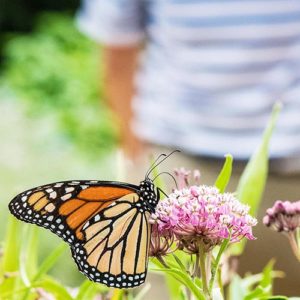
Thank you!
These amazing individuals go above and beyond every month to provide financial support which helps us create so much free content for everyone to enjoy and learn from.
Julie Krygier, Lizabeth, Russel Furnari, Crystal Robinson, Karen Veleta, Kevin B, Sally Mirick, Crystal Dyamonds, Mitchell Bell, Laura Hunt, Sue Ann Barnes, Adrienne Richardson, J. Adam Perkey, Ariel, Cara Flinn, David Todd, LaVonne Fitts, Cathy, Michael, Tom Winner, Eric Fleming, Julie, SB H, Christopher Scully, Craig, Rachel Antonucci, Melissa Egbertson, Switzy, CotswoldsCottageMA, Vilma Fabre, Pia O Nomata, Linda McNees, HerculesBiggerCousin, Patrick Dwyer, Paul Gourley, Lilith Jones, John Master, William Morin, Lori Sadie Ann, Debra, Ayn Zitzman, Han Mad, Isaac Kowis, Cathy Anderson, Betsy Lessels, Reid, and Dave Teare.
Backyard Ecology™: Creating thriving backyard ecosystems that you can enjoy and be proud of
We created Backyard Ecology™ to help you confidently create pollinator and wildlife habitat that you can enjoy and be proud of. Because nature isn’t just “out there.” It’s all around us, including right outside our doors.
Our focus on the eastern U.S. means that the information we share is applicable to you and where you live. Join us as we ignite our curiosity and natural wonder, explore our yards and communities, and improve our local pollinator and wildlife habitat.
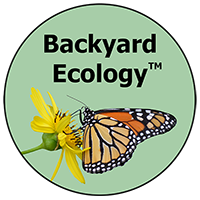
Backyard Ecology™’s Guiding Principles:
🦋 Curiosity: Nature is fun, interesting, and worth exploring. We will never know everything. Answers lead to more questions. That’s half the fun.
🦋 Balanced: You don’t have to choose. You can support nature AND have a beautiful property that you can enjoy and be proud of.
🦋 Science informed: Habitat creation and management should be based on the latest scientific research available. This is true regardless of whether you’re working in a small garden or on hundreds of acres.
🦋 Stewardship: Anyone can make a positive difference in the natural world and leave an ecological legacy on their property.
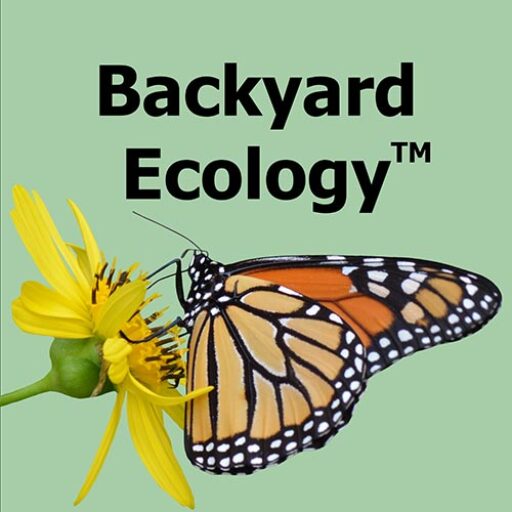
Leave a Reply